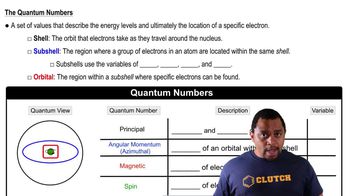(a) Ibuprofen is a common over-the-counter analgesic with the formula C13H18O2. How many moles of C13H18O2 are in a 500-mg tablet of ibuprofen? Assume the tablet is composed entirely of ibuprofen.
Very small semiconductor crystals, composed of approximately 1000 to 10,000 atoms, are called quantum dots. Quantum dots made of the semiconductor CdSe are now being used in electronic reader and tablet displays because they emit light efficiently and in multiple colors, depending on dot size. The density of CdSe is 5.82 g/cm3. (c) What is the mass of one 6.5-nm CdSe quantum dot?
 Verified step by step guidance
Verified step by step guidance
Verified video answer for a similar problem:
Key Concepts
Quantum Dots

Density and Volume Calculation

Nanotechnology in Electronics

Very small semiconductor crystals, composed of approximately 1000 to 10,000 atoms, are called quantum dots. Quantum dots made of the semiconductor CdSe are now being used in electronic reader and tablet displays because they emit light efficiently and in multiple colors, depending on dot size. The density of CdSe is 5.82 g/cm3. (a) What is the mass of one 2.5-nm CdSe quantum dot?
Very small semiconductor crystals, composed of approximately 1000 to 10,000 atoms, are called quantum dots. Quantum dots made of the semiconductor CdSe are now being used in electronic reader and tablet displays because they emit light efficiently and in multiple colors, depending on dot size. The density of CdSe is 5.82 g/cm3. (e) If you wanted to make one 6.5-nm dot from multiple 2.5-nm dots, how many 2.5-nm dots would you need, and how many CdSe formula units would be left over, if any?
(a) One molecule of the antibiotic penicillin G has a mass of 5.342×10-21 g. What is the molar mass of penicillin G?
(b) Hemoglobin, the oxygen-carrying protein in red blood cells, has four iron atoms per molecule and contains 0.340% iron by mass. Calculate the molar mass of hemoglobin.
